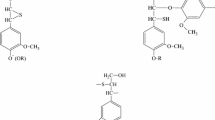Summary
The probability of bond between wood components and glyoxal was examined by means of a mechanical method, infrared (IR) spectrometry, and solid state 13C-nuclear magnetic resonance (NMR) spectrometry. The successive fixation of a compressed wood by the glyoxal treatment suggested the formation of cross-linkings between wood components and/or wood structures. The IR spectra showed that ester bond as well as ether bond was formed between wood components and glyoxal. The existence of linkages between glyoxal and cellulose was indicated also from the NMR spectra. The addition of glycol to the glyoxal solution was investigated from the viewpoint of stabilizing effect of the linkages. When 0.2 mole ratio of glycol was added to 5–10% glyoxal solution, weight gain and antiswelling efficiency (ASE) were largest, however the addition of excessive amount of glycol did not advance further the weight gain and ASE. When an appropriate amount of glycol was added to the impregnation solution, both weight and ASE did not largely reduce even by the repeated hot water soaking. By the treatment without glycol, the dimensional stability after water soaking was attributed to only restraint of the swelling. On the other hand, when the glycol was added, the dimensional stability was developed not only by the restraint of the swelling but also by the buckling effect.
Similar content being viewed by others
References
Harrington, K. J.; Higgins, H. G.; Michell, A. J. 1964: Infrared spectra of Eucalyptus regnans F. Muell. and Pinus radiata D. Don. Holzforschung 18: 108–133
Haw, J. F.; Maciel, G. E.; Schroeder, H. A. 1984: Carbon-13 nuclear magnetic resonance spectrometric study of wood and wood pulping with cross polarization and magnetic-angle spinning. Anal. Chem. 56: 1323–1329
Head, F. S. H. 1958: The reactions of cellulose with glyoxal. J. Textile Inst. 49: T345-T356
Inoue, M.; Morooka, T.; Norimoto, M.; Rowell, R. M.; Egawa, G. 1992: Permanent fixation of compressive deformation of wood. (II) Mechanisms of permanent fixation. Bull. New Zealand FRI 176: 181–189
Jones, E. J. 1949: The infrared spectrum of native spruce lignin. Tappi 32(4): 167–170
Maciel, G. E.; Kolodziejski, W. L.; Bertran, M. S.; Dale B. E. 1982: 13C NMR and order in cellulose. Macromolecules 15: 686–687
Nakano, T. 1994: Reaction of glyoxal and glyoxal/glycol with wood. Wood Science and Technology 28: 23–33
Tanahashi, M.; Goto, T.; Horii, F.; Hirai, A.; Higuchi, T. 1989: Characterization of steam-exploded wood III. Transformation of cellulose crystals and changes of crystallinity. Mokuzai Gakkaishi 35(7): 654–662
Weaver, J. W.; Nielson, J. F.; Goldstein, I. S. 1960. Dimensional stabilization of wood with aldehyde & Related compounds. Forest Products J. 10: 306–310
Welch, C. M. 1983: Glyoxal as a formaldehyde-free durable press reagent for mild curing applications. Textile Res. J. 53: 181–186
Welch, C. M. 1984: Glyoxal-glycol mild cure process. Formaldehyde-free durable press finishing of cotton. Textile Chem. Color. 16(12): 265–270
Welch, C. M.; Danna, G. F. 1982: Glyoxal as a non-nitrogeneous formaldehyde-free durable-press reagent for cotton. Textile Res. J. 52: 149–157
Welch, C. M.; Peters, J. G. 1987: Low, medium, and high temperature catalysts for formaldehyde-free durable press finishing by the glyoxal-glycol process. Textile Res. J. 57:351–356
Yasuda, R.; Minato, K. 1994a: Chemical modification of wood by non-formaldehyde cross-linking reagents. Part 1: Improvement of dimensional stability and acoustic properties. Wood Sci. Technol. 28: 101–110
Yasuda, R.; Minato, K.; Norimoto, M. 1994b: Chemical modification of wood by nonformaldehyde cross-linking reagents. Part 2: Moisture adsorption and creep properties. Wood Sci. Technol. 28: in press
Author information
Authors and Affiliations
Additional information
We would like to thank Associate Professor Dr. Umezawa, Wood Research Institute, Kyoto University, for his invaluable support in NMR analysis. Thanks are also due to Dr. Inoue, Wood Research Institute, Kyoto University, for his preparing the wood specimens.
Rights and permissions
About this article
Cite this article
Yasuda, R., Minato, K. Chemical modification of wood by non-formaldehyde cross-linking reagents. Wood Sci.Technol. 29, 243–251 (1995). https://doi.org/10.1007/BF00202084
Received:
Issue Date:
DOI: https://doi.org/10.1007/BF00202084




